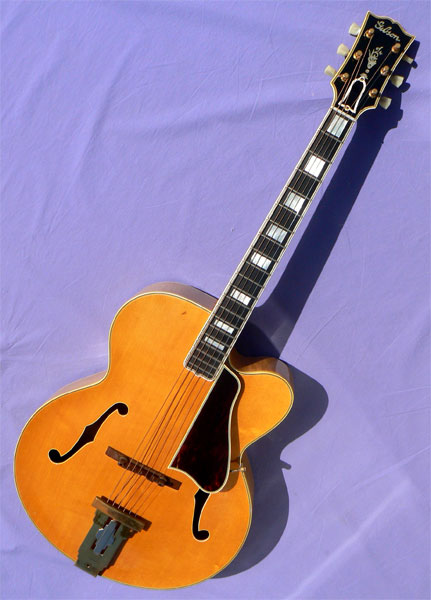

Instruments /Accessories / Ordering / Tips
archtop.com

1941 Gibson L-5 Premiere
Price and Status: For pricing and hold status of this instrument, please check here. If this instrument does not appear on the Instruments page it has been sold. To be notified of examples of this or any other model in the future, please email your specific requests to [email protected].
Serial #: 96594
Body size at lower bout: 17". Scale length: 25 1/2" Nut Width: 1 11/16" Neck depth: .90-.99, 1st-10th fret
Finish: Blonde finish, nitrocellulose type.
Materials: Intensely figured solid bookmatched bubble maple back; hand graduated bookmatched solid spruce top; flame maple neck and sides; quintuple bound solid ebony fingerboard with mother of pearl inlay; quintuple bound peghead and body with bound f-holes.
Hardware: Original gold engraved L-5 Varitone tailpiece; compensated adjustable Brazilian rosewood bridge. Postwar vintage Kluson Sealfast tuners; vintage correct bound tortoise pickguard.
Notes: Gibson revolutionized the guitar world in 1939, with the introduction of its first archtop instrument with a cutaway body. Available for almost a decade only on the upscale L-5 and Super 400 models, these 'Premiere' cutaway versions were the first truly modern archtops, offering enhanced access to the full range of the fingerboard. At the same time, Gibson returned the model to its original parallel bracing pattern, for increased projection and cutting power. Premium priced over their noncutaway counterparts, the Premiere series were at the very pinnacle of Gibson's catalog. And as the newly introduced natural finish was used only on the most extravagantly figured instruments, the blonde cutaways were the most expensive guitars the company had ever produced.
According to our invaluable colleague Andre Duchossoir, Gibson's shipping ledgers reveal that this handsome instrument was well traveled indeed. One of only 9 blonde cutaways from its model year, this guitar was designated "L-5PN' in the ledger, and first shipped on January 8th of 1941 to Aegerter Music House in South Dakota. Later that year the guitar was returned to Gibson and reshipped to Grossman Music in Ohio, before finally being delivered to a 'Band Officer', presumably with the US Armed Forces.
During this era, Gibson obtained its figured maple locally from northern Michigan, in the vast forests upstate from its factory in Kalamazoo. The breathtaking 'bubble' or 'blister' maple gracing this guitar is of a variety rarely seen today, and is highly coveted for its spectacular three-dimensional grain pattern. The sides and neck are crafted of solid flame maple, with a soundboard hand graduated of old-growth Sitka spruce, sourced from the Olympic Peninsula. The engraved art-deco tailpiece has Gibson's "Varitone" angle adjuster, an innovation allowing the player to adjust the string angle over the bridge.
The gold Kluson Sealfast tuners are the costliest tuning machines ever made, and were offered only on the L-5 and Super 400 models. With their single-ring tulip buttons, this particular set would appear to have been replaced at the Gibson factory sometime in the early postwar era, when the guitar may have been sent back for a refret, as the binding nibs are still undisturbed at the fret ends. A postwar white oval label was also affixed, still bearing the original serial number, as labels were commonly updated when instruments were returned to the factory.
Meticulously maintained, the instrument is in phenomenal condition, and remarkably free of pick, buckle, thumb or fingerboard wear. At just 6lb, 7oz, the guitar is notably light in weight, and deftly balanced on the lap or the strap. The neck angle and bridge height are both excellent, with smooth, low action over a solid, gently rounded 'C' profile neck, and a fresh high-precision setup. The multi-ply binding is original and tight to the body, and the suspended fingerboard offers ample clearance for installation of a floating pickup as well.
The natural blonde finish has ambered warmly over the decades, showing some fine light checking, all consistent with its age. Apart from a few scattered lacquer nicks and scratches, the instrument shows few signs of playwear altogether. The voice is warm, woody and focused, with particularly sparkling reverb in the upper register. And fittingly, the instrument is nestled in its original Geib striped tweed 'aircraft cloth' case, the most desirable of Gibson's prewar hardshells, and every bit as handsome as the guitar it shelters.
The top of the heap, and the rarest (and most eye-catching) of all prewar L-5s, this spectacular guitar combines classic design, vintage tone, and modern performance in one magnificent package. One only: call now.
Setup: Trussrod tension and neck relief adjusted; bridge height adjusted; bridge compensation strobe tuned; string slots at nut and bridge inspected and recut as necessary; bridge wheels and tuners lubricated; fingerboard and bridge oiled; body and neck cleaned and hand polished. This instrument is strung with medium gauge phosphor bronze strings (.013-.056), and will accommodate lighter or heavier gauge strings, according to preference. String action is set at 4/64" to 5/64" at the 12th fret, with moderate relief for vigorous acoustic playing. The action may be lowered or raised to your requirements with the adjustable bridge.
Case: Original striped tweed Gibson hardshell case with pink plush lining.





